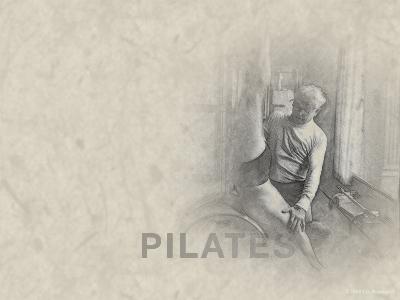
Joseph Hubertus Pilates was a man ahead of his time. As early as 1914 he had observed that by pulling in our lower abdominal muscles when exercising, we create what he called "the powerhouse" - ba stron center. With a strong 'powerhouse' we could then 'return to life' and become fit and healthy. More recently, research from the world of physiotherapy has proven the link between the same abdominal muscles that Pilates worked with (particularly the transverses abdominis) and back health.
Pilates was also a great proponent of a holistic approach to health, embodying mind, body and spirit; focussing on the importance of correct breathing, focus, precision and control.
As a child Pilates suffered from Asthma, Rickets and Rheumatic fever. This prompted him to study both Eastern and Western forms of exercise and to become a competent skier, diver and gymnast. Pilates moved to England in 1912 where he earned a living as a boxer, circus performer, and self-defence trainer for the police force.
When World War 1 broke out, Pilates was interned with other German nationals in Lancaster. Whilst he was interned, Pilates became a nurse and during this time, he designed exercise apparatus for immobilized patients by attaching springs to hospital beds.
His observations and work here were to form the foundation for his style of body conditioning and specialized exercise apparatus. Once the war was over he returned to Germany to continue his work in devising a physical programme. In 1925 the German government asked Joseph to start training the German army, but instead, he chose to emigrate to New York. He met his future wife Clara on the boat trip to America and, together, they established a studio in New York, in 1926, to teach and share his knowledge and fitness programs.
Pilates’ studio soon became popular with the dancing community as it offered them a chance to recover from injuries and improve and strengthen their technique. Dance legends such as Ruth St Denis, Ted Shawn, Martha Graham, George Balanchine and Jerome Robbins were amongst the many that experienced his teachings.
Pilates had his first major publication in 1934: ‘Your Health’ offered basic advice, regarding posture, body mechanics, correct breathing, spinal flexibility, and physical education and includes his early Twentieth Century philosophies, principles, and theories about health and fitness. He based his work on the concept of a balanced Body and Mind, drawing on the approach espoused by the early Greeks.
While some of his personal philosophies reflected early 20th Century viewpoints, his athletic and fitness doctrines were years ahead of his time. He describes the results of decades of scientific study, experimentation and research into the variety of troubles and ills that upset the balance of body and mind. Pilates called his overall program of physical fitness exercises ‘Contrology’.
Pilates also wrote ‘Return to Life Through Contrology ’ in 1945, in partnership with William J. Miller. This book details the original 34 exercises recommended to accompany the basic advice offered separately in ‘ Your Health’. These carefully designed exercises constitute the results of decades of scientific study, experimentation and research into the variety of physical ills that upset the balance of body and mind. The exercises were highly specialized and advanced but Pilates would constantly adapt and vary exercises to clients’ specific needs, and this legacy of dynamic teaching continues today.
Pilates lived to the age of 87, a fitting tribute to the effectiveness of his training methods and fitness exercises.